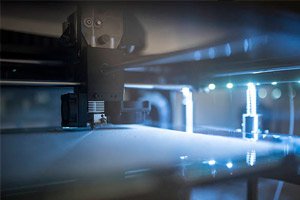
All iLive content is medically reviewed or fact checked to ensure as much factual accuracy as possible.
We have strict sourcing guidelines and only link to reputable media sites, academic research institutions and, whenever possible, medically peer reviewed studies. Note that the numbers in parentheses ([1], [2], etc.) are clickable links to these studies.
If you feel that any of our content is inaccurate, out-of-date, or otherwise questionable, please select it and press Ctrl + Enter.
Scientists Create 3D-Printed Living Lung Tissue
Last reviewed: 27.07.2025
 ">
">Researchers at UBC Okanagan have developed a 3D bioprinted model that closely mimics the complexity of natural lung tissue – an innovation that could transform how scientists study lung diseases and develop new treatments.
Irving K. Barber Faculty of Sciences Associate Professor Dr. Emmanuel Osei says the model produces tissue that closely resembles the complexity of the human lung, which could improve respiratory disease testing and drug development.
“In order to do our research and the tests we need to do, where we're studying the mechanisms of complex lung diseases to ultimately find new drug targets, we need to be able to create models that are comparable to human tissue,” he says.
The team of researchers used a bioink made of photosensitive polymer-modified gelatin and a polymer called polyethyleneglycol diacrylate to 3D print a hydrogel containing multiple cell types and channels to recreate the vascular structure of the human airway.
Once printed, the hydrogel behaves much like the complex mechanical structure of lung tissue, improving the way we study how cells respond to stimuli.
“Our goal was to create a more physiologically relevant in vitro model of the human airway,” says Dr. Osei, who also works with UBC’s Heart and Lung Innovation Centre. “By integrating vascular components, we can better model the lung environment, which is critical for studying disease and testing drugs.”
Dr. Osei explained that when a person is diagnosed with lung cancer, a surgeon - with the patient's consent - can remove the affected area along with some normal lung tissue and donate these samples to researchers.
“However, a researcher has no control over how much tissue they receive,” he explains. “Sometimes it may just be a small piece of tissue that is brought to the lab and treated with various chemicals for testing. Now, with 3D bioprinting, we can isolate cells from these donor tissues and potentially recreate additional tissue and test samples to conduct research in our labs without relying on new donor samples.”
Many lung diseases are currently incurable, including chronic obstructive pulmonary disease (COPD), asthma, idiopathic pulmonary fibrosis and cancer, Dr. Osei said. The ability to create models for testing is a significant step forward in respiratory disease research and drug development.
The study, published in the journal Biotechnology and Bioengineering in collaboration with Mitacs and supported by Providence Health Care, is a step toward understanding aspects of lung disease such as scarring and inflammation and may lead to future cures for a variety of diseases.
The paper described tests including exposing a bioprinted 3D model to cigarette smoke extract, which allowed the researchers to observe an increase in pro-inflammatory cytokines, markers of lung tissue's inflammatory response to nicotine.
“The fact that we were able to create this model and then use specific triggers, such as cigarette smoke, to demonstrate how the model responds to and mimics aspects of lung disease is a significant step forward in understanding the complex mechanisms of lung disease and will help us understand how to treat them,” says Dr Osei.
“Our model is complex, but due to the reproducibility and optimal nature of bioprinting, it can be adapted by adding additional cell types or cells derived from specific patients, making it a powerful tool for personalized medicine and disease modeling.”
Dr. Osei notes that continuing this work puts his research team in a unique position to collaborate with colleagues from organizations such as UBC's Immunobiology Eminence Research Excellence Cluster, biotech companies, and anyone interested in developing bioartificial models.
